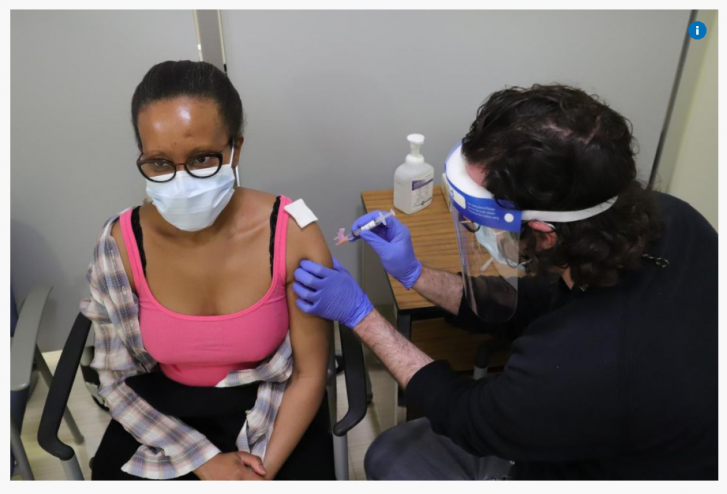With Ontario’s rate of first COVID-19 vaccine doses plateauing, the province’s family doctors are getting a new tool to help reach the roughly 22 per cent of adults who haven’t yet received a shot.
The “Aggregate Primary Care Vaccination Report” will be available mid-July, according to a letter from Ontario Health’s Dr. David Kaplan and Dr. Sacha Bhatia, sent last week to family physicians who enrol patients. Itwill provide primary care physicians with access to information about which patients have been vaccinated, when, and the type of vaccine, so they can find those falling through the cracks.

“It is really important to get these lists to us so that we can start to make those calls,” said Dr. Tara Kiran, a family physician at St. Michael’s Hospital in Toronto.
“We can actually change people’s minds.”
But for the most part they still can’t give them the shot during their appointments. There have been pilot programs at doctors’ offices but the vaccines are not yet widely available there.
Dr. Noah Ivers, a family doctor and researcher at Women’s College Hospital who recently received a grant from the Canadian Institutes of Health Research to study the initiative, said the new tool will be very useful, as he often gets patients asking him what he would do.
“As a family doc you see people through thick and thin over the years, and it goes a long way, ultimately, when there’s uncertainty,” he said.
“Unless we do things like this, a lot of things like this, to go push the first dose level beyond where it is now to closer to 90 per cent, we’re going to keep seeing flare-ups of COVID,” he added, especially when kids head back to school.
But like Kiran, he feels this should be “complemented” by having more vaccines in family doctors’ offices.
“If I just had a few on hand at my office and then refilled those few every week that could make a big difference,” he said.
“If we’re each just catching a few of these people who, for lack of a better term have been left behind, every week, then that gets us closer to the 90 per cent.”
Alexandra Hilkene, a spokesperson for Minister of Health Christine Elliott, said in an emailed statement the province has enabled public health units “to request larger vaccine allotments for their primary care partners,” with recent increased vaccine supply.
“The onboarding of additional primary care settings to administer vaccines continues and is ongoing by public health units,” she added.
Ontario Health’s media relations team was not able to provide comment by deadline.
While Kiran has already started routinely asking patients when they come in for appointments about vaccines, the new tool will allow her to track vaccinations in a much more systematic way.
At the beginning of the rollout she got a lot of relatively straightforward questions. But she said it’s now more “a combination of the fear with, it’s not super easy to just get the vaccine.”
Patients come with queries related to their health conditions, allergies, mixing and matching vaccines, or social media misinformation. Some are housebound and may just have been missed. One recently showed her a video claiming to show post-vaxx side effects “that I know as a physician are not possibly related to the vaccine.”
“If I’m able to convince somebody it’s often because they trust me,” she said.
“They trust that I have their best interests at heart and that I am knowledgeable about the science of the vaccines.”
In the city and province “we’re approaching 80 per cent” of adults with at least a first dose, noted Dr. Dara Maker, a family doctor at Women’s College Hospital.
“But that’s one-fifth of our population, of our eligible population that isn’t vaccinated. That’s still a significant proportion of people and often it’s that phone call from somebody’s primary care provider, and they take that opportunity to answer their specific questions that helps them move toward being closer to getting vaccinated.”
The tool will take some back-end hustle by doctors to cross-reference with patient lists to find the ones who haven’t received the shot, and Kiran noted, it will be harder for physicians working outside of family health teams to find the time. It also only works for family doctors under the patient enrolment model, who get paid per patient, and doesn’t apply to those who bill for each individual service.
Kiran and staff at her family health team have already been booking vaccine appointments as the complex web of vaccine portals is still a barrier for some.
“Sometimes I feel like it’s really important to close the deal if the patient is in the room or on the phone,” she said.
Having doses available at doctors’ offices would make it even easier, she added And at this point, any little thing to nudge up the vaccination rate is needed.
She likens the vaccine rollout to a home reno, where “the last five per cent of a renovation takes 95 per cent of the time.”
Article From: The Star
Author: May Warren is a Toronto-based breaking news reporter for the Star. Follow her on Twitter: @maywarren11

